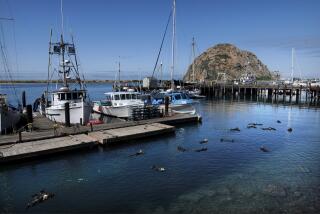ANATOMY OF A SPILL
- Share via
A typical sewage spill begins when rocks, tree roots or grease block a sewer main under a city street. Sewage backs up in the main, spilling out at the lowest point of escape. That point can be a manhole or someone’s toilet. (Pump Station 64 spills directly into Los Penasquitos Lagoon when there is a failure.)
SPILLS INTO PUBLIC WATERS:
If the sewage escapes through a manhole, it will run into a storm drain and flow toward a public body of water, such as Mission Bay.
Someone calls the city Water Utilities Department about sewage in the street. A “leak” crew is dispatched to size up the problem and call in a report to a dispatcher at the Chollas Operations Center. The crew will estimate how many gallons are spilling and which way the sewage is heading.
The dispatcher calls the county Health Department, which directs the city water department to post quarantine signs around the public waters being infiltrated by sewage. The city must call the county Health Department within 24 hours of any spill.
The city water department also calls the state Regional Water Quality Control Board and the U.S. Environmental Protection Agency’s regional offices in San Francisco. If the spill involves Mission Bay, the department will call the office of City Councilman Mike Gotch, whose district includes the aquatic park.
A second water crew is sent to the scene to try to stop the flow of sewage. The city often uses a vacuum truck, which sucks up the sewage at a powerful rate.
Under Proposition 65, the county Health Department must issue a press release within 24 hours of a spill. The law went into effect on Jan. 1.
BACKUPS INTO BUILDINGS
The city water department is called if sewage backs up into a private home or business. The caller is asked how many drains are backwashed with sewage and if any large objects, such as diapers, have been flushed down the toilet recently.
One of five emergency crews available around the clock is dispatched to the home or business. The crew must first determine what is blocked. If the lateral--the 4-inch pipe that runs between a home and the sewer main--is clogged, the citizen is told to call a plumber because the stoppage is his responsibility. This is the problem in the overwhelming number of cases where only one house on a street is flooded.
If the problem is found to be in the sewer main (tree roots, for example), it is the city’s responsibility. The emergency crew then calls for an additional crew to help dislodge the source of the stoppage. A large snake or a powerful vacuum is usually used to clear the sewer.
If crews are unable to clear the sewer, a hose may be run into manholes and around the blockage to keep sewage flowing toward treatment. This temporary detour is used until the pipe can be repaired.
A standby city water department supervisor is called to the scene to see what kind of damage has been done to businesses or residences. The supervisor then calls a member of the city’s Risk Management Department, who will arrange for cleanup crews and hotel accommodations for affected residents, if necessary.
People whose property is damaged in a sewage backup can submit a claim to the city’s Risk Management Department. The costs are verified and then paid under a city policy that encourages payments to mollify upset residents.
More to Read
Sign up for Essential California
The most important California stories and recommendations in your inbox every morning.
You may occasionally receive promotional content from the Los Angeles Times.












